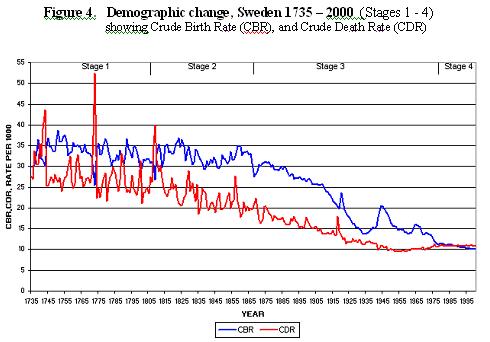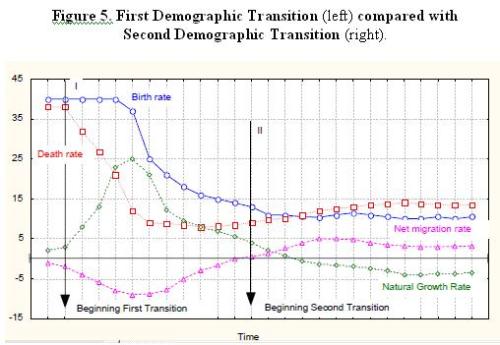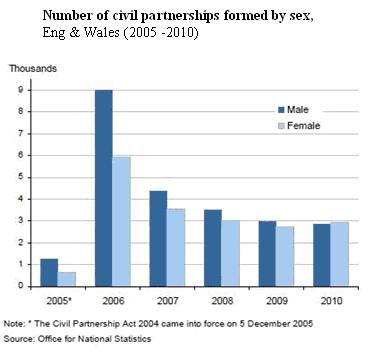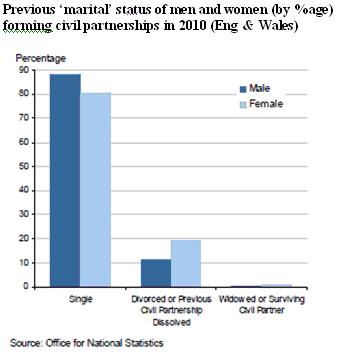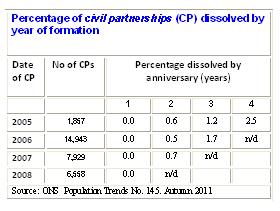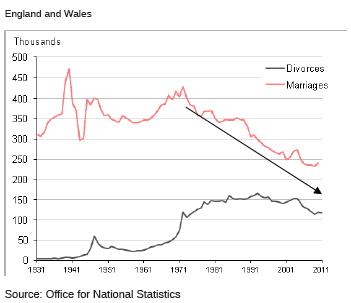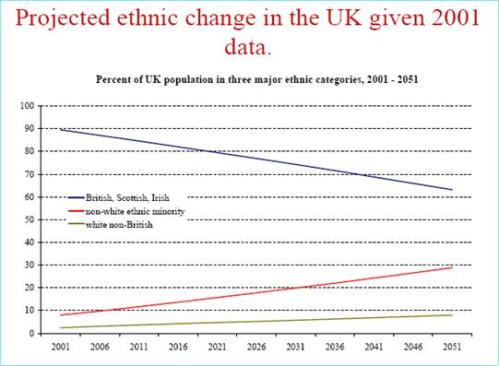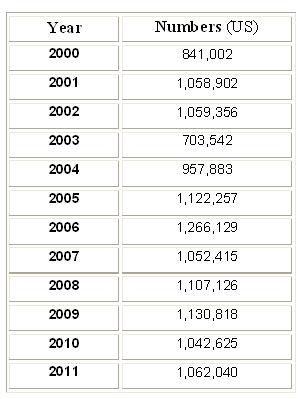by Robert Whiston FRSA June 2013
Quantifying both the public demand and the underlying lack of demand for homosexual marriage among the homosexual community
Same-sex marriage has become ‘flavour of the month’ all across political Europe. Why ? The crusade – for that is what it amounts to – sweeping Europe is reminiscent of the great Divorce Reforms Acts of the 1969 – 71 era or the more recent tobacco Smoking Ban in public places. For 10 years or more (as Annex 3 shows) the seemingly idiotic idea of two adult men, or women, being able to marry one another has been allowed to colonise our minds.
Is same-sex marriage the new distraction ? Is it being used to replace the old remedy of foreign adventures to distract a restless populous given that such adventures have proven convoluted, complicated and costly ? This can’t be the answer for most of Europe but it seems a good fit for France and the UK. The argument used to promote same-sex marriage it is that present law discriminates against one section of society i.e. homosexual men and women. But though they may, after a fashion, copulate they have never throughout history expected to procreate and produce children. Until the advent of IVF treatments it has thus been a sterile and time truncated occupation.
At present not only the UK but France is stomaching or digesting – depending on one’s view – having to live with same-sex marriage as a new fact of life but cope with same-sex adoption. Both countries are in more of an economic crisis than is being suggested in their respective domestic media and both countries are already in or being tempted to join foreign escapades.
Both Cameron’s and Hollande’s political career may well look back and rue the day they took this option. They may come to see it as a ‘Pyrrhic victory’, ie one with such a devastating cost that it carries the implication that another such victory will ultimately lead annihilation. Ergo, it is a victory that is not worth winning because the winner losses so much in winning it that it opens the door for others.
In the British example it will probably lead to a Conservative slaughter at the next General Election at the hands of UKIP. What fate awaits the Gallic Hollande one can’t even speculate given that he has the unenviable title of being the President to have lost most public support most quickly. France’s greater love of street demonstrations has seen the same-sex marriage debate ignite otherwise quiet sections of the population. The future should be interesting; Spain’s Nov 2011 general election delivered a landslide victory to the People’s Party, whose leader, Mariano Rajoy, opposes same-sex marriage.
Decay then stability.
Efforts to normalise and incorporate homosexual practices into the mainstream have slowly met with success since the late 1990s. Characteristically, after the initial euphoria of getting same-sex legislation  passed, numbers that had once shot up soon start to decay. This can be seen in the first graph showing the same-sex marriage numbers in the Netherlands (Holland) when it was legalised in 2001 (Note: same-sex unions, or same-sex ‘partnerships’ were legalised in 1998).
passed, numbers that had once shot up soon start to decay. This can be seen in the first graph showing the same-sex marriage numbers in the Netherlands (Holland) when it was legalised in 2001 (Note: same-sex unions, or same-sex ‘partnerships’ were legalised in 1998).
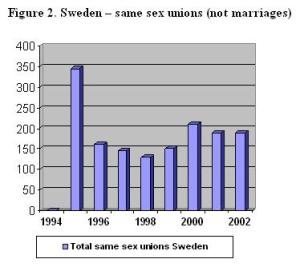 This pattern of numerical collapse is common to many countries where this law has been passed, eg Sweden, UK.
This pattern of numerical collapse is common to many countries where this law has been passed, eg Sweden, UK.
According to Dutch government agency Centraal Bureau Voor de Statistiek (Statistics Netherlands), the number of gay marriages has 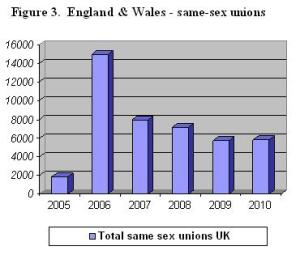 dropped off steadily since the laws came into effect.
dropped off steadily since the laws came into effect.
Sweden which legalised same-sex unions in 1995 is unusual among “liberal” countries in that it did not legalised same-sex marriage until 2009. (Most countries follow a pattern of legalising 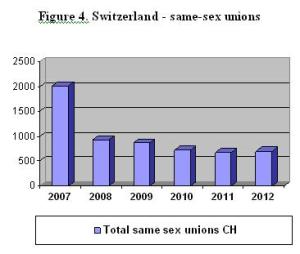 same-sex marriage several years after legalising same-sex unions / partnerships – not over a decade].
same-sex marriage several years after legalising same-sex unions / partnerships – not over a decade].
Britain also exhibits the same sudden rise in homosexual unions followed by a steep decay pattern after the legalising same-sex unions. Peaking at 14,943 in 2006 it quickly fell by two-thirds that figure (5,804) in 2010. In the ONS report into same-sex union numbers (Population Trends, No 145), we learn that the state recognised unions in 2004 (but which came into force on Dec 2005), as part of a long-term political agenda:
- “. . . thus fulfilling a long-standing political promise to the Gay community.”
Switzerland which passed a same-sex registered partnerships law in 2005. The fall her has been more dramatic than most – from 2,004 in 2007 to only 695 in 2012.
Pioneers
Holland was the first country to pass same-sex ‘marriage’ legislation in 2001 but it was Denmark which passed the first same-sex ‘union’ legislation in 1989 (see Table below). Same-sex union legislation appears to be the preferred paving tactic or bridging step prior to pressing for same-sex marriage and the ‘right’ to adopt children.
Statistics Netherlands reports that 80% of its 4.1 million heterosexual couples marry compared with only 20% of Dutch homosexual couples which number only 55,000 same-sex couples. Put another way if heterosexual couples marry did not marry but 20% wanted that right, would that wish be fulfilled by government ? The homosexual “20%” represents a mere 2% of all marriages in Holland. So whereas ‘normal’ marriage is a natural choice for heterosexual men and women it is almost the exception for the homosexual community:
- Between 1 April 2001 and 1 January 2011, there were a total of 14,813 same-sex marriages in the Netherlands. The number of marriages between two women (7,522) was slightly higher than those between two men (7,291). In the same period, there were 761,010 marriages.
- During the same period, there were 1,078 same-sex divorces in the Netherlands, two-thirds of them between women (734), and 323,549 divorces in general
The above paragraphs would indicate that overall 7% of same-sex marriages have ended in divorce, but it is higher, at 9.7%, among lesbians (14,813 same-sex marriages / 1,078 same-sex divorces = 7.2%).
In the general scheme of things one source, the Institute for Marriage and Public Policy (Vol. 4, No. 3, May 2011) the number of same-sex marriages in the Netherlands at only 10 % (1 in 10 ), whereas “Expatica.com” (a Dutch international news and communications media company founded in 2000), puts the number at 20% (1 in 5). [1]
Comparing nations
Thus in a 10 years period, same-sex marriages in the Netherlands amounted to no more than one year of same-sex unions in the UK. Given that, one wonders what will be the impact on UK numbers when same-sex marriages are legalised ? Spain, with a population of 47 million, comes closest to England & Wales (56m), but even here the greatest annual number of same-sex couples who married totalled only 4,500 in 2006 which was the first full year of operation. Thereafter it too tapered off.
Having said earlier that there was usually a time delay between converting to Same-sex Marriages after Same-sex Unions had been introduced the gaps are inconsistent, as the following Table (Table 1), illustrates:

With the exception of a few countries like Portugal and Spain, which go straight to full-blown same-sex marriages, most nations prefer to test the water. There appears to be no set pattern in the yearly wait, ie the ‘delay’ gap 

Above: Figure 5 – gay marriages in Europe by country.
getting shorter or longer, but one gets the feeling that a 23 year wait – as in the case of Denmark – is unlikely to happen again. Moreover, the delay gap would appear to be getting ‘concertinaed’, that is to say more legislation is being passed more rapidly after 2001 with the delay gap falling.
The result, in geopolitical terms, can be see in the map above (Figure 5). Those countries shown in red ‘outlaw’ same-sex unions of any description. Those in ‘grey’ (Russia, Black Sea, Adriatic Sea), do not recognise same-sex unions.
Currently, Norway, Sweden, Iceland, Denmark, Netherlands, France, UK, Germany, Switzerland, Portugal and Spain have some form of same-sex marriage or same-sex union (see map above). Only ardently religious countries such as Italy, Greece and Turkey are nominally agnostic and have yet to be convinced. While some form same-sex union is accepted as far east as Hungary, the former Eastern Bloc shown in red, e.g. Poland, and grey have no such provisions or tolerance. Indeed, the red area see marriage as a wholly heterosexual activity.
Where, one wonders, are the Muslim voices who form a significant part of the modern EU’s population ? Any other policy initiative would fist have to pass an “impact assessment” where consideration of their sensibilities towards homosexuality would be assessed and then bought into the discussion. But this has not happened. And to then go on from there to legalise same-sex marriage anyway is to throw the rule book away.
Lesbian ascendency
One of the unintended consequences – apart from the ‘flash in th pan’ number of homosexual males who marry or register a union, is growth in lesbian numbers.
 Figures produced by Swedish Stats are shown in Fig 2 (above) and depict the numbers of civil unions by sex from 1995 to 2007. Whereas lesbian unions which were once less than homosexuals ones in 2002 had by 2007 well exceeded them (by over 50%). Official statistics from Statistics Sweden (”Statistiska centralbyrån Forecast Institute”, Stockholm) state that in:
Figures produced by Swedish Stats are shown in Fig 2 (above) and depict the numbers of civil unions by sex from 1995 to 2007. Whereas lesbian unions which were once less than homosexuals ones in 2002 had by 2007 well exceeded them (by over 50%). Official statistics from Statistics Sweden (”Statistiska centralbyrån Forecast Institute”, Stockholm) state that in:
- ”2008 was the first time that the number of female registered partnerships was greater than the number of male registered partnerships. It was a minor difference though with 1,223 female and 1,214 male partnership(s).” [2]
Yet as we can see from Figure 6 this is not true. The graphic from ‘Statistics Sweden’ shows 2004 as the cross-over year and 2005 as the first year female partnerships exceeded male ones. The only possible explanation is that Statistiska centralbyrån is referring to the cumulative total over the years 1995 – 2007, i.e. 1,223 female and 1,214 male ‘in toto.’
Later Swedish Statistics show that by 2009 there were 8,513 lesbian marriages and  only 6,995 male homosexual marriages.
only 6,995 male homosexual marriages.
This pattern of lesbian overtaking male homosexual is repeated in several countries. In Britain which has a shorter track record of homosexual unions the trend seems to be the same. Once a minority in 2006, Lesbian civil unions 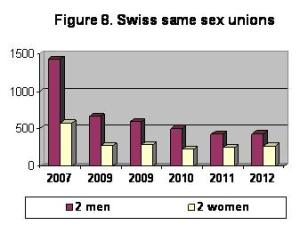 overtook male homosexual numbers by 2010.
overtook male homosexual numbers by 2010.
However, Switzerland and Spain are presently the odd-ones-out with still more men entering unions than women from 2007 to 2012 and 2006 to 2011, respectively.
Constitutional Crisis
The introduction of a new English law permiting the first born to automatcally become the next monach, no matter what sex they may be , has huge implications that have perhaps not been thought through. If the next first born is a girl and then later marries a man called Mr. Robinson, what will happen to the Windsors ? Are they expected to move out as nore and more Robinson children are born and their relatives take presciodence ? Does he become Co-King, Regent, Cconsort ?
Within the context of homosexuality, it it not unknown for a serving King to be homosexual (e.g. Edward II, James I), but to do their “duty” by marrying a woman and producing an heir – prefereably with a spare. What potential dilemma s then lie ahead ? We could hae a homosexual King who marries a another man and adopts a child on the pretence of contining the royal lineage. How will the public wear that proposition ? At present, not very well is the immediate answer.
At present it is not possible in England for an adopted child to succeed to the throne – but who says that law will still be standing in 10 years time ?
Conversely, if a girl is sometime in the future the next Queeen, she too could marry another woman and the same scenario of ‘adoption’ would be played out. What are the protocols and terminiolgy, eg the Prince Consort, etc. ?
Significant
Collecting data from the various countries is not straightforward; some countries have missing years, i.e. gaps, some are not as up to date as others, and some sources conflict.
However, there is a discernible underlying tone or tendency to produce cumulative numbers. Reports and articles, especially in Gay publications, often begin with sentences such as these:
- “In a survey of marriage in Sweden between 1995 and 2002, there were 1,526 gay partnerships registered compared to 280,000 heterosexual couples.”
- “Since 1 April 2001, when the Netherlands became the first country to legalise same-sex marriage, some 15,000 gay and lesbian couples have tied the knot.”
To the casual observer these appear to be enormous numbers and fully justify the legal reforms. But when ‘annualised’ they are puny with unions and marriages measured in the hundreds and, in the instance of Britain, the low thousands.
Patricia Morgan, in a presentation to the UK parliament, made the following observations:-
- “Norway moved to ‘gender-neutral’ marriage in 2008.
- Sweden followed in 2009 and imposed its law virtually overnight without consultation. Since marriage, particularly in Sweden , has long had little or no recognition or status, partnerships morphed seamlessly into marriage and the two have been treated de facto and, for all intents and purposes, as virtually identical – both before and after the transition.”
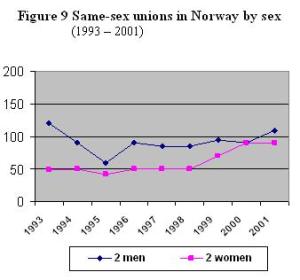
Data from Norway is interesting since same-sex unions have had more time to bed-down. Perhaps it reflect the tentative nature of the radical change (or Nordic restraint) towards same-sex unions but there is no spectacular spike or surge followed by a collapse in numbers as seen in other countries. On the contrary, they have been fairly consistent for almost 10 years.
In countries where there is no public desire for ‘gender-neutral’, i.e. same-sex, marriage it has been imposed on the population from “on high” and against the general public’s wish – which in a democracy is surely an oxymoron, i.e. a contradiction in terms.
On wonders whether the Gay fraternity, piloting this reform throughout the various countries, have any real idea of the downside and the full implications of living a heterosexual lifestyle ? How will they cope with asset confiscation when divorcing ? Or can they reconcile being a parent unable to see ‘their’ child ?
Annex 3 (below) contains a sample of just such tragedies – and there will be far more after the reforms have bedded-in.
Though the following commentary is disparaged by many Gay website it bears repeating here. According to a report of the Institute for Marriage and Public Policy (IMAPP) and based on data from 2004: [3]
- “There is a high rate of divorce among homosexual couples in Sweden. Gay male couples were 50% more likely to divorce within eight years and lesbian couples 167% more likely to divorce than heterosexual couples. In the Netherlands, between April 2001, when gay marriage was legalised, and December 2003 there were 5,751 gay marriages and 63 divorces.
Next steps
‘Softly, softly catchee monkey’ appears to be the reformer’s “modus operanti”; start with same-sex unions, move on to same-sex marriage, and lastly same adoption of children by same-sex couples. Occasionally, where a country’s laws permit single persons to adopt a child this is avenue is commandeered.
The argument used to promote same-sex marriage it is that present law discriminates against one section of society, i.e. homosexual men and women, and unduly favours heterosexual couples. But though they may consider that they copulate after a fashion (using the primary canal or gastrointestinal tract), they have never expected to procreate and produce children. Not that is until the advent of IVF treatments.
Historically, it has thus been a sterile and private occupation (and offending no one in the general population), albeit one granting some degree of ‘gratification’ with male participants using the upper and lower gastrointestinal tract. Female homosexuals achieve ‘gratification’ using the vagina but with the aid of instruments acting as a proxy penis.
The foundation of this claimed ‘right’ to be as equal as heterosexuals is therefore a self-centred one – not one based on the rights of the child or the adult obligations towards a child which in most legal precedents ‘trumps’ any adult claim.
The right to be a parent follows on from the right to be in a state – recognised union or marriage. But in the huffing and puffing of this “normalisation crusade” the financial ruin consequent upon a divorce will far outweigh any income tax benefit or inheritance tax gain
The general population while they may murmur under their breath are prepared to be tolerant of homosexual relationships to tolerate same-sex unions, however, same-sex marriage and adoption is going one and two steps too far for many.
We may come to view same sex-marriage argument as a re-run of the divorce reform of the 1970s. Twenty and even thirty years on, those ‘enlightened’ reforms are ruining the lives of millions of children and costing the state billions of pounds in social rectifications and remedies.
The speed of adopting such pro-homosexual legislation is disconcerting. When one considers how hard it has been in the past 30 years to get the barest of rights for children to see each their parent equally (shared parenting) the contrast becomes jaw dropping. One suspects that the prime movers have used their well-placed homosexual political friends to accelerate what would normally be a slow and a frequently frustrating process.
Adoption
Bitter controversy surrounds this topic and in the final analysis one has to admit that there is insufficient evidence to call it one way or the other. Nevertheless several nations are plunging headlong into this Endeavour when they don’t even allow a biological parent ( a father) to have the same sort or rights or allow him the same degree of latitude to claims of “risk”.
This is an overt case of double standards operating against all heterosexual fathers – but who cares about them ?
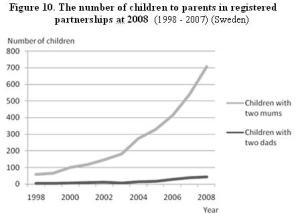 The graph here (Figure 10)shows the number of children adopted by same-sex couples in Sweden, by year.
The graph here (Figure 10)shows the number of children adopted by same-sex couples in Sweden, by year.
It is interesting to note that overwhelmingly it is lesbians that feel the urge ‘to mother’, or at least look ‘normal’ to the outside world by pushing a pram and taking children to school.
What is wrong with this, one might ask ? They may be lesbians but they are essentially still female and feel their biological clock ticking away just like any other women.
What is wrong with this is that lesbian women are many times more violent than heterosexual men. Such men, when they divorce – and even when they don’t – are often accused of posing a ‘threat’ to children and their accusers are believed. They are then – often wrongly – removed from the lives of their children and yet that is precisely what lesbians and male homosexual also now want ? (see Annex 3 below).
As long ago as Jan 1999 this was an acknowledged fact with this caveat appearing on the website of Britain’s Home Office webpage (Fri Jan 22nd 1999):
- “Domestic violence includes all kinds of physical, sexual and emotional abuse within all kinds of intimate relationships. The most harmful abuse is carried out by men against female partners, but abuse can also occur by women against men and within same-sex relationships.” — Home Office Web page Fri 22/1/99
The last ten years have seen the number of children living in Swedish partnership families grow tenfold. There were less than 70 children living with parents in registered partnerships at the end of the 1990s. However, by 2008 there were 749 children younger than 21 years of age living with two women or two men in registered partnerships.
Rather confusingly ’Statistics Sweden’ reports that:
- The great majority of these children live together with two women, 706 children compared to 43 children who live with women who are registered partners. Children are common among female registered partnership families.
One has to suppose that the balance of ”43 children who live with women who are registered partners” refers to children over the age of 21. Nearly 40% of the female couples have children living at home. There is an average of 1.5 children in those partnership families with children. Half of these children are younger than age 4.
Staying in Sweden, since May 1st 2009 All couples, regardless of sex or orientation have been able to technically ’marry.’ Once again the majority of same-sex marriages involve women. In May 2009, 37 female couples were married compared to only 11 male couples (only weddings between persons not already/previously civilly registered as partners are included here).
When the law on registered partnership (unions) was first introduced in 1995 there were three times as many men as women who registered their partnership. Since then the number of men in partnerships has been greater than the number of women. Only time will tell what will be the trend for same-sex marriages in Sweden. [4]
Divorce
In essence fault-based divorce and custody were yesterday’s battles. The law has changed and forced fathers to change with it but why does that mean that the ‘innocent party’ still has to lose so completely ?
The double bind is that divorce, by its very definition has pitted male and female protagonists against one another in an atmosphere of public expectation and everywhere political rhetoric must be seen to uphold the guarantee of gender equality. This historic ‘gender equality’ has played itself out in the guise of court awards in favour of the ‘most vulnerable party’, invariably
seen as the mother/woman, being given the weaponry to inflict severe damage on the other ‘stronger’ party. But how will this work in same-sex scenarios ?
Until very recently custody disputes were seen as a straight-forward male/female gender equality issues. Since 2004 heterosexual men and women no longer have the monopoly of custody battles. Translated into plain English, the gender equality issue was the cause taken up by women activists to keep mothers in the driving seat and custody within their jurisdiction (and out of the hands of ordinary fathers who wanted to spend time with their children). Homosexual ‘rights’ to child adoption puts the existing an unenviable position when separation occurs. Where will the bias be seen between two of the same-sex ? (see Annex 3).
Which side of the fence will be better served by the judiciary in future custody awards, lesbian couples or homosexual couples, is still unclear. One group – or possibly both – will sooner or later become dissatisfied with the trend they see and it is at that point that the Father’s Movement (for political advantage) should consider joining with them to push for change.
Compared to its predecessor, No-Fault based divorce excludes the concept of fault and precludes any legal enquiry into guilty or gross misconduct. It is accepted by government that the usual ‘grounds for divorce’ will not be equal to heterosexual couples, e.g. for homosexuals adultery is not a ground for a divorce petition. The rationale of such a regime is that henceforth the resulting hardships of divorce should be borne equally but separately by the two parties – but not for heterosexual couples, apparently.
In the effort to normalise their place in society homosexuals and lesbians may be jeopardising their existing civil liberties. The whole point of cohabiting and homosexual relationships is that they are ‘under the state’s radar.’ Cohabiting for both heterosexuals and homosexuals is a private agreement reached between to adults.
Marriage, while it ‘gifts’ the state’s recognition and donates rights and privileges which cost it next to nothing since they are paid for by the taxpayer, i.e. those marrying, it also imposes punitive sanctions for any breach. Separation is a matter of exercising “free choice” just as equally as the initial joining together was a personal “free choice – but legitimising same-sex unions alters all that.
The courts are not slow to interfere in marital matters and may at times impose a social penalty or a change on people against their will. Pressing for legalised unions and marriages brings a once free section of the population under the remit of the courts and creates a new flash point. So although the intention is to give rights, privileges and benefits to homosexuals, same-sex marriage and unions may actually take away several basic rights that have been taken for granted.
Legitimately it was blackmail that was a homosexual’s greatest fear in the years before the Wolfenden Report and the Act legalising homosexual sex between adults consenting in private. Today, that fear has been replaced by being accused of coercive sexual assault and or rape of another male. In this instance homosexuals have achieved a dubious parity with heterosexuals e.g. the homosexual Deputy Speaker (2013) and heterosexual Neil Hamilton MP (2001), both accused of rape. In the case of Neil Hamilton it was a false claim made by a sexual “fantasist.”
The right to be governed by laws that are fair are a universal ambition; opposite-sex married couples “merit” certain benefits for two reasons. First, heterosexual marriage is generally beneficial to society. Second, opposite-sex married couples incur financial risks when they have children. Marital rights, privileges and benefits are given to heterosexual married couples in consideration of their “merits” (i.e. social contributions and needs). To extend these benefits to Gays and Lesbians is an unfairness since they cannot reproduce as a couple and for them to do so incurs greater expanse and a redirection of funds away from the needs of the general population.
Equally homosexuals may well find – as have heterosexuals – that trying to defend against a false claim of rape or sexual impropriety is loaded against them and they may come to the view that the ‘el dorado’ of equality is in fact self-defeating.
End
ANNEX 1 – graphs & tables
Gay marriage (not unions)
Gay marriage timeline (chronology)
- Netherlands (2001)
- Belgium (2003)
- Spain (2005)
- Canada (2005)
- South Africa (2006)
- Norway (2009)
- Sweden (2009)
- Portugal (2010)
- Iceland (2010)
- Argentina (2010)
- Denmark (2012)
- Uruguay (2013)
- New Zealand (2013)
- France (2013)
—————————————————-
Switzerland:
Total unions by sex 
and by year


.
.
.
.
.
————————–
Holland:
Total unions by sex 
and by year 
.
Once again we see a divergence between official statistics. The above table shows 1,355 same-sex marriages composed of 601 homosexuals and 754 lesbians. However, the lower Table shows 1,071 homosexuals partnerships, for 2011, and 1,084 lesbians partnerships. Even if we assumed they referred to only ‘unions’ the figures still do not tally.
.

.
————————————————–
Sweden:
Total unions by sex 
and by year
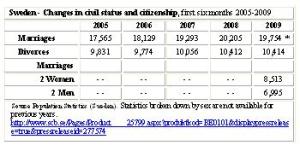
.
.
.
.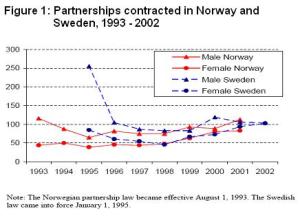
.
——————————————–
England & Wales:
Total unions by sex 
and by year
.
.
.
Source: “Civil Partnerships Five Years On” Population Trends No. 145 Autumn 2011 http://www.publications.parliament.uk/pa/cm201213/cmhansrd/cm130205/debtext/130205-0002.htm [Gender sum-totals for the years 2008 – 2010 have been deduced from data]. 
.
.
.
NB. There were 1,857 civil partnerships formed in England and Wales in the 11 days available in December 2005. However, there are slight discrepancies in ONS data regarding actual numbers, e.g. 2005, which shows 1,953 in one publications while in another 1,857 (see below) and also 16,106 for 2006 (see Tables below). 

.
.
———————————————-
Spain:
Totals by sex 
and by year (not unions)
.
.
.
.
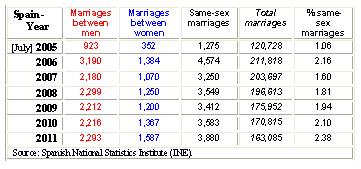
.
.
Statistical yearbook 2009 [Spain]

.
.
.
.
.
.
ANNEX 2 – text & references
The first country to introduce legal recognition of same-sex unions was Denmark in 1989, and the term “registered partnership” was invented for that purpose.
Legislation in each country appears to have had influential and or homosexual politicians working behind the scenes or at least not hindering its progress. e.g. former Deputy Speaker at the House of Commons charged in May 2013 with indecent assault and rape of two males.
Denmark:
Registered partnerships (Danish: registreret partnerskab) in Denmark were created by a law enacted on 7 June 1989, the world’s first such law, and came into force on 1 October 1989.[3][4] It was extended to Greenland on 26 April 1996,[5] and later amended in 1999. Three attempts to expand the law in May 2003,[6][7][8] another in June 2003.
Same-sex marriage became legal in Denmark on 15 June 2012. The bill for legalisation, introduced by the government of Helle Thorning-Schmidt, was approved by the Folketing on 7 June 2012 and received Royal Assent on 12 June 2012
UK:
From a standing start of zero, civil unions in England & Wales mushroomed to over 16,000 in 2006. But in the following year only about half that number of civil unions were registered, i.e. 8,742.
There were 1,857 civil partnerships formed in England & Wales in the 11 days available in December 2005 and 14,943 throughout 2006. By 2010, only 5,804 civil partnerships were formed throughout the year, a large decrease since 2006.
The number of partnerships in England and Wales peaked at 4,579 in the first quarter of 2006 and remained over four thousand in the second and third quarters, but fell to 2,175 in the fourth quarter. There were 7,929 civil partnerships formed in England and Wales in 2007, a decrease of 47 per cent compared with 2006. This large decrease may reflect the fact that many same-sex couples in long-standing relationships took advantage of the opportunity to formalise their relationship in 2006, the first full year in which civil partnerships could be formed.
The number of civil partnerships decreased again in 2008 and by 2009 had fallen to 5,687 partnerships. Numbers in 2010 increased slightly by 2.1 per cent compared with 2009. This small increase may indicate that a steady level has been reached.
Civil partnership rates
Civil partnerships formed in England and Wales in December 2005 equated to an annual rate of 8.1 men per 1,000 unmarried men aged 16 and over registering a partnership, and a rate of 3.7 for women (Table 1). By 2006, the rate had decreased to 1.8 per 1,000 unmarried men and 1.0 per 1,000 unmarried women aged 16 and over. By 2010, provisional rates had fallen further and less than one person (0.5) per 1,000 unmarried adults aged 16 and over entered into a civil partnership in England and Wales.
Holland:
Dutch Radio:
‘Ten years of same-sex marriage: a mixed blessing’
Just 20% of Dutch homosexual couples are married, compared with 80% of heterosexual couples, fresh figures byStatistics Netherlands show. Between 1 April 2001 and 1 January 2011, there were a total of 14,813 same-sex marriages in the Netherlands.
The number of marriages between two women (7,522) was slightly higher than those between two men (7,291). In the same period, there were 761,010 marriages (source: Dutch Radio).
According to provisional figures from Statistics Netherlands, for the first six months, same-sex marriages made up 3.6% of the total number of marriages: a peak of around 6% in the first month followed by around 3% in the remaining months: about 2,100 men and 1,700 women in total. By June 2004, more than 6,000 same-sex marriages had been performed in the Netherlands (source: Statistics Netherlands).
In March 2006, Statistics Netherlands released estimates on the number of same-sex marriages performed in each year: 2,500 in 2001, 1,800 in 2002, 1,200 in 2004, and 1,100 in 2005 [this is not ‘Registered partnerships’] (source: https://en.wikipedia.org/wiki/Same-sex_marriage_in_the_Netherlands ).
“Same-sex couples in the Netherlands” and from “What is the future for ‘civil unions’ ?” http://www.cbs.nl/NR/rdonlyres/74975167-2503-43A0-8821-66F88DA2B6B2/0/samesexcouples.pdf
According to agency statistics, 2,400 gay marriages took place in the portion of 2001 during which gay marriage was legal, with 1,800 couples following suit in 2002. That number dropped to 1,500 same-sex couples marrying in 2003, out of a total of 82,600 marriages.
Sweden:
In a survey of marriage in Sweden between 1995 and 2002, there were 1,526 gay partnerships registered compared to 280,000 heterosexual couples. Five out of every 1,000 new couples in Sweden are same-sex, and 62% of those are gay male unions.
Divorce: There is a high rate of divorce among homosexual couples in Sweden. Gay male couples were 50% more likely to divorce within eight years and lesbian couples 167% more likely to divorce than heterosexual couples. In the Netherlands, between April 2001, when gay marriage was legalized, and December 2003 there were 5,751 gay marriages and 63 divorces.
In statistics taken from couples filing cases for gay marriage in America, the couples fighting for the right to marry have been together for an average 10 years.
In a single year, 1998, the population of Sweden grew by 6,697 but by 2008 it had inflated to an annual increase of 73,420 (source: Preliminary Population Statistics, by month, 2006 – 2009 http://www.scb.se/Pages/TableAndChart____25897.aspx ).
Divorce-Risk Patterns in Same-Sex “Marriages” in Norway and Sweden, by Gunnar Andersson 1, Turid Noack 2, Ane Seierstad 2, and Harald Weedon-Fekjær http://www.uni-koeln.de/wiso-fak/fisoz/conference/papers/p_andersson.pdf
Swedish Statistics http://www.scb.se/Pages/PressArchive____259760.aspx?PressReleaseID=276777
‘Marriage and Divorce by Country’, Isocrat.org http://isocrat.org/science/demog/mar_stats.php#madbc
Portugal:
Same-sex marriage has been legal in Portugal since 5 June 2010.[1][2] The government of Prime Minister José Sócrates introduced a bill for legalization in December 2009; it was passed by the Assembly of the Republic in February 2010.
Spain:
Same-sex marriage in Spain has been legal since 3 July 2005. In 2004, the nation’s newly elected social democratic government, led by socialist Prime Minister José Luis Rodríguez Zapatero, began a campaign for its legalisation, including the right of adoption by same-sex couples.[1] After much debate, a law permitting same-sex marriage was passed by the Cortes Generales (Spain’s bicameral parliament, composed of the Senate and the Congress of Deputies) on 30 June 2005 and published on 2 July 2005.
France:
Same-sex marriage has been legal in France since 18 May 2013.[1] It is the thirteenth country worldwide to allow same-sex couples to marry. The legislation applies to the French Overseas departments and territories.
Germany:
Since 1 August 2001, Germany has allowed registered partnerships (Eingetragene Lebenspartnerschaft) for same-sex couples. These partnerships initially provided many but not all of the rights of marriage, and currently provide all except joint adoption and full tax benefits. As of 22 October 2009, the Federal Constitutional Court of Germany has ruled that all the rights and obligations of marriage be extended to same-sex registered partners.
Switzerland:
Switzerland recognises same-sex registered partnerships. In a nationwide referendum on June 5, 2005, the Swiss people approved by 58% a registered partnership law, granting same-sex couples the same rights and protections as opposite-sex couples, except . . . .”
Annex 3
a). Mother loses her children to former lesbian partner
By Frances Gibb, Legal Editor The Times , April 7, 2006
http://business.timesonline.co.uk/tol/business/law/article702829.ece
TWO young sisters were taken away from their biological mother and handed over to her former lesbian partner on the orders of the Court of Appeal yesterday.
In a landmark ruling that boosts the rights of same-sex partners, the two girls, aged 7 and 4, will now be cared for primarily by the former lesbian partner instead of their mother.
[ Question – Would you ever get two young sisters taken away from their biological mother and awarded to their biological father ? – RW ]
b). Divorce-Risk Patterns in Same-Sex “Marriages”
in Norway and Sweden
(2004)
http://www.uni-koeln.de/wiso-fak/fisoz/conference/papers/p_andersson.pdf
Exctract:
4. The populations of registered partners in Norway and Sweden
Our first observation is that the incidence of same-sex marriage in Norway and Sweden is not particularly impressive in terms of numbers. Our data for Norway consist of 1,293 partnerships contracted 1993-20019. During the same calendar period, 190,000 heterosexual marriages were entered, which gives a ratio of around 7 new same-sex marriages to every 1,000 new opposite-sex marriages.
For Sweden our data comprise 1,526 partnerships entered 1995-20029. Related to the corresponding 280,000 heterosexual marriages registered during the same calendar period, we get a ratio of 5 new partnerships to every 1000 new opposite-sex marriages.
The ratios of partnerships to marriages are thus considerably lower than the various estimates of fractions of homosexuals that we referred to in Section 2. The incidence of partnership formation in the two countries also appears relatively low when compared to the levels of partnership formation in Denmark and the Netherlands (Waaldijk 2001: 463; Noack et al. 2002: Figure 1; Eggen 2002: 229; Digoix et al. 2004).
Trends in partnership formation by country and sex (Figure 1) reveal that the developments in annual numbers of new partnerships have been quite similar in the two countries. Both countries exhibited a particularly high level of partnership formation immediately after the legislation on registered partnerships came into force . . . . .”
c). Predicting the number of civil partnerships
by Robert Whiston, Fri, 23/10/2009 – 12:29
http://www.straightstatistics.org/article/predicting-number-civil-partnerships

d). Messy Lesbian divorces
By Glenn Sacks, MA Executive Director, Fathers & Families & Ned Holstein, M.D., M.S.Founder, Chairman of the Board, Fathers & Families glenn@glennsacks.com
See also the rise of lesbian custody Battles
(http://glennsacks.com/blog/?p=4311 )
20th October 2009
Ned Holstein, MD and I co-authored a new piece for MSN.com on lesbian child custody battles. Regardless of whether one supports or opposes gay marriage, lesbian custody battles are enormously illustrative of the dynamics behind heterosexual family court battles.
Mothers are often able to convince courts to allow them to drive decent, loving fathers out of their children’s lives by employing anti-father/pro-mother stereotypes and by portraying dads as abusive or unfit. But there are no abusive males or bad dads in lesbian custody battles. Nevertheless, when two lesbians agree to have a child together and the relationship goes sour, the lesbian biological mom often does the exact same thing to her ex as heterosexual mothers do.
Certainly there are abusive fathers from whom mothers need protection in family court, but when a mother decides to drive a father out of his kids’ lives, abuse or unfitness isn’t usually the motivation.
The column is With Gay Marriage Comes Gay Divorce: The Rise of Lesbian Custody Battles (MSN.com, 10/15/09). We wrote:
- It’s not every day that America’s conservative Christians rally around the cause of a lesbian. Yet numerous groups are providing support and expensive legal services for Lisa Miller. Miller’s cause? To deny her former civil union partner Janet Jenkins any role in the life of the daughter they raised together.Miller and Jenkins joined in a same-sex civil union in Vermont in 2000 as Lisa Miller-Jenkins and Janet Miller-Jenkins, and had a child named Isabella Miller-Jenkins together in 2002. Lisa was artificially inseminated from a sperm donor who they chose because his physical traits closely matched Janet’s, who became Isabella’s social mother. According to the Washington Post:”When Isabella was born, Janet had the honor of cutting the umbilical cord … Lisa and Janet had researched how best to bond with the baby … [at night] ‘Every two or three hours, Isabella would wake up so Lisa could nurse her,’ Janet said. ‘I would take Isabella from that point. I would burp her … I would rock her. She would go back to sleep on my heartbeat’ … Janet’s parents were enthralled, and embraced Isabella as their newest grandchild.”In 2004 Miller decided to leave Jenkins and move to Virginia, agreeing to a liberal parenting time schedule for Jenkins, who paid child support to Miller. Yet after Miller got to Virginia, she violated the agreement, deciding that she wanted sole custody of Isabella and excluding Jenkins from the child’s life. The Liberty Counsel, a close partner of the late Rev. Jerry Falwell’s Liberty University, has spearheaded Miller’s legal case.Jenkins, who has helped care for children at day care centers in two states, treasures pictures she has of Isabella helping her in their garden, picking through her purse and playing with wooden trains. “These are hard to look at … we were happy,” she says. She remembers how Isabella would say “Uppy” when she wanted Janet to pick her up.Miller, who became a Christian and renounced lesbianism after leaving Jenkins, even pushed aside Jenkins’ parents, who Isabella adores and who live near Miller. Janet’s dad Bucky, a retired firefighter who’s been married to his wife Ruth for over 50 years, says, “The loser in the whole thing, of course, was the baby.”Vermont judges have seen the dispute Jenkins’ way throughout the case. On Aug. 25 a Vermont court found Miller in contempt, imposing a fine on Miller if she continues to violate Jenkins’ court-ordered visitation.Miller could have been incarcerated by the court but Jenkins — showing Miller a kindness both unreciprocated and unmerited — told the court she didn’t want Miller jailed. What she wants is to see her daughter. Afterwards, Miller declared that she’s going to continue her legal battle to keep Isabella away from Jenkins “because that’s what a Christian is supposed to do.”Miller is, of course, entitled to choose her own sexuality and religion. But she chose to have a child with Jenkins and shouldn’t be able to obliterate this because it doesn’t fit in with her new beliefs. And however one feels about gay marriage, it is enormously damaging to children to have one of the two people they love the most in the world — a parent — ripped out of their lives. The saddest part is that children usually blame themselves, asking, “What did I do to make mom not want to be with me anymore?”Lesbian custody battles are now becoming routine, and dozens of them have been the subject of hotly contested cases in recent years. Some of the biological mothers are so determined to drive the social mothers out of their children’s lives that they even invoke laws which limit gays’ parental rights as a way to win their cases.LGBT (lesbian, gay, bisexual and transgender) activists believe courts haven’t adequately protected the rights of lesbian social mothers because of the tenuous legal status of gay marriages and relationships, and they’re partly correct. But much of the problem lies in the way courts treat noncustodial parents, regardless of sexual orientation. Most of Miller’s tactics are well known to noncustodial fathers…
Read the full column at: With Gay Marriage Comes Gay Divorce:The Rise of Lesbian Custody Battles (MSN.com, 10/15/09).
e). Another closet
by Adam Dawson, The Guardian, Monday Jan. 8th 2007
Violence in same-sex relationships often goes unmentioned – and is increasingly common, writes Adam Dawson
http://society.guardian.co.uk/socialcare/comment/0,,1982005,00.html
Research carried out by Prof Hester shows that the victims of abuse within same-sex relationships are more likely to go to friends for help than women who suffer abuse at the hands of male partners, who are more likely to report the incident to the police.
Regardless of the sex or sexual orientation of the perpetrator, domestic abuse revolves around power rather than physical strength.
Victims often say that the psychological and emotional abuse outweighs the physical abuse, which stays with a person for longer than the scars of physical abuse.
Chris Lyle, from the School of Health at Wolverhampton University, said: “The traditional focus of men as perpetrators and women as victims has dominated academic debate and development of policy to the detriment of a wider understanding of violence within other forms of intimate relationships. It also means that current resources for victims are aimed at straight women which prevent gay men and women receiving help and support.”
The research carried out by Prof Hester and her team shows that domestic violence is a huge problem in same sex relationships and that men are more likely to experience abuse from their partner.
Some behaviour such as rape may go unreported because of victims’ difficulty in naming their experience
f). ‘News, Same-sex ‘marriage’ has negative effects, shows latest evidence’
https://www.spuc.org.uk/news/releases/2013/march02
by Dr. Patricia Morgan (March 2013)
London, 2 March 2013: The experience of legalising marriage for same-sex couples in Europe and North America shows that such legalisation has negative effects for real marriage and for families, shows latest evidence.
The evidence was presented to the House of Commons committee examining the Marriage (Same Sex Couples) Bill, in a written submission by Dr Patricia Morgan, the British family policy researcher, on behalf of the Society for the Protection of Unborn Children (SPUC) www.spuc.org.uk The submission can be read in full at www.spuc.org.uk/campaigns/ssmsub20130301
Based on research and data from Sweden, Norway, Denmark, the Netherlands, Spain, Canada and the US, Dr Morgan concluded that:
- as marriage is redefined to accommodate same-sex couples, this reinforces the idea that marriage is irrelevant to parenthood
- same-sex marriage leads to the casualisation of heterosexual unions and separation of marriage and parenthood
- Spain saw a pronounced acceleration in the decline of marriage following the introduction of same-sex marriage (same-sex marriage was introduced at the same time as the ‘express divorce bill’)
- across all countries analysed, no causal link has been established to support the idea that same-sex marriage prevents marital decline
- in the move to same-sex marriage, opposite-sex relationships have to conform to gay norms rather than vice-versa
- a publicly-professed, legal, partnership does not prevent homosexual couples from breaking up more frequently than married heterosexual couples
- experience with same-sex partnerships/marriage legislation tends to suggest that availability is all, and participation more or less irrelevant to sexual minorities
- same-sex marriage may be the end-game of long-running anti-marriage, anti-family policy typified by Sweden
- same-sex marriage may begin the process of severing marriage from family in otherwise family-friendly societies such as Spain and the Netherlands
- same-sex marriage triggers dismemberment of family structures in family-friendly societies.
As a pro-life organisation, SPUC campaigns against same-sex marriage because:
- marriage – the permanent, exclusive union of one man and one woman – is the basis of the family, the fundamental group unit of society. Upholding marriage is therefore in everyone’s interests.
- marriage as an institution protects children, both born and unborn. Statistics show that unborn children are much safer within marriage than outside marriage.
- same-sex marriage lacks basic elements of true marriage e.g. the complementary sexual difference between spouses necessary for the procreation and healthy upbringing of children.
- same-sex marriage represents an attempt to redefine marriage, thus undermining marriage. This undermining lessens the protection for unborn children which true marriage provides.
SPUC is working with the Coalition for Marriage (C4M) to oppose the British government’s plans to legalise same-sex marriage. SPUC published a position paper on same-sex marriage following a resolution by SPUC’s Council. SPUC has also made available a background paper to be read in conjunction with the position paper and which provides some additional references and reflections.
g). Human Fertilisation and Embryology Bill (H of L)
http://www.publications.parliament.uk/pa/ld200708/ldhansrd/text/71119-0004.htm
[NB. Ruth Deech, was one of the architects of the divorce reform chaos of 1969 – RW ]
19 Nov 2007 : Column 674
However, I feel that I should take issue with two clauses. Clause 14 would omit a child’s need for a father as a consideration in the assessment of welfare that has to be carried out by the doctor proposing to treat a woman. I hope that this new clause can be removed so that we revert to the law as it stands—the careful and sensitive compromise worked out in 1990, as described by the noble and learned Lord, Lord Mackay, which has held firm for all that period. The requirement is, after all, only to consider the need; it is not an absolute ban on treatment by any means, and it is well known that many single women and gay couples receive IVF treatment at clinics and have children. The argument for removing it is that it is now public policy to treat all families equally and to avoid any discrimination between persons on grounds of gender and sexual orientation and because there are inconsistencies and unknowns in the way that the provision is applied. There is no need for a father, it is said, especially given that there is provision in the current Bill for two women to be the legal parents of a child.
Does a child really not need a father? Clearly, the need for a mother remains unchallenged—it is implicit in the way that the law works. I think that a child needs a father. First, we are where we are. To remove the requirement that a child needs a father is to make a fresh statement to the effect that a child does not need a father. It sends a message to men, at a time when many of them feel undermined as providers and parents, contrary to government policy in this field. Government policy is that men should pay for their children after divorce and separation and that they should take responsibility. Divorce law judges hold that contact with a father after divorce is a good thing. Recently, the Government have sought to encourage single women to name the father of their babies on the birth certificates. We are told that children who find out that they are adopted or created by donor insemination need to know their fathers. The United Nations Convention on the Rights of the Child says that every child has the right to know and to be cared for by both parents and of course anonymity has been removed from sperm donors, which must mean that they are important.
There is a wealth of research showing that children need fathers, not just a parent. Children need to see complementary roles, the relationship between the sexes, a microcosm of society as they grow up. There is also research showing that children born to lesbian parents do well, but it is limited research, mostly carried out by one researcher in this country and of necessity the children are very young. Some research shows that those children suffer from the inevitably confused and secretive family relationships that occur.
Recent reports have placed Britainat the bottom of the international league tables for the welfare of children and we know that boys without parents fail at school, that they turn to worse role models and that fathers play a great part in the upbringing of their children as well. A survey reported this morning shows that 77 per cent of the public would keep the law the way it is. After all, if a woman is pregnant and her husband dies during the pregnancy, do we not say that is a tragedy?
h). Same sex parents
“Adopting the parent trap”
Legalization the adoption of children by Homosexual parents.
Sydney Morning Herald, May 7th 2003
The issue of gay adoption in Tasmania has rekindled debate on whether or not children need a female and a male parent, writes Bettina Arndt.
Extract
http://www.smh.com.au/articles/2003/05/06/1051987702147.html?oneclick=true
“. . . . American researchers Robert Lerner and Althea Nagai, experts in the field of quantitative analysis, evaluated 49 studies on homosexual parenting – studies often used to “prove” that a child is not adversely affected by gay parenting. All 49 studies were found to have at least one major flaw.
Lerner and Nagai, who published their 2001 analysis in a paper entitled ‘No Basis: What the Studies Don’t Tell Us about Same-Sex Parenting’, conclude: “The methods used … are so flawed that these studies prove nothing … the studies on which such claims are based are all gravely deficient …Therefore they should not be used in legal cases to make any arguments about homosexual versus heterosexual parenting.”
This conclusion was shared by Professor Lyn Wardle, who criticised the same-sex parenting research in a 1997 article in the University of Illinois Law Review. After examining the use of this research in US legal cases, Wardle argues that until concerns about the current “badly flawed” research are dispelled, “*it would not be rational to adopt a public policy endorsing or legitimating homosexual parenting*”.
Last year [2002] a British sociologist, Dr. Patricia Morgan, weighed in with her own analysis, ‘Children as Trophies – Examining the Evidence on Same-Sex Parenting’. Morgan criticises the research for often including only very young children, which precludes any possibility of picking up long-term effects. She says many of the children spend their formative years in heterosexual families before the homosexual family is formed, which makes findings difficult to interpret.
The few studies which track children to adulthood are also flawed, according to Morgan. She criticises Fiona Tasker and Susan Golombok’s work published in ‘Growing Up in a Lesbian Family’ for comparing children of lesbian women who have PhDs with those of poorly educated lone parents and for downplaying negative effects such as teasing by peers.
Morgan says is it is astonishing that “gushing personal testimonies” by lesbian parents should be “reverentially accepted by public bodies, academics and research institutes who would immediately laugh away the use of similar materials as evidence elsewhere”….
Sarantakos’s research, which compared 58 children of same-sex couples with the same number in matched heterosexual families, found a far higher proportion of children in the same-sex families
identified themselves as homosexual or were labelled as such by their parents. He found that result unsurprising because the gay family provides both factors likely to provide the genesis for homosexuality – environment plus genetic make-up.
See “Children as Trophies – Examining the Evidence on Same-Sex Parenting”. By Patricia Morgan, http://www.amazon.co.uk/exec/obidos/ASIN/1901086186/wwwlink-software-21/026-2359530-3083610
E N D
References:
- http://www.pbs.org/newshour/bb/law/gay_marriage/unions.html
- http://www.statistics.gov.uk/downloads/theme_population/PopTrends137web.pdf
- http://www.rnw.nl/english/article/ten-years-same-sex-marriage-a-mixed-blessing
- https://www.spuc.org.uk/news/releases/2013/march02
- https://en.wikipedia.org/wiki/Same-sex_marriage_in_the_Netherlands
- http://www.cbs.nl/NR/rdonlyres/74975167-2503-43A0-8821-66F88DA2B6B2/0/samesexcouples.pdf
- http://www.loveandpride.com/informationcenter/tips.aspx?categoryid=5
- http://www.scb.se/Pages/PressArchive____259760.aspx?PressReleaseID=276777
- http://www.publications.parliament.uk/pa/cm201213/cmpublic/marriage/memo/m94.htm http://www.straightstatistics.org/article/predicting-number-civil-partnerships
Footnotes:
[1] See http://www.expatica.com/nl/life-in-netherlands/lifestyle/Same-sex-marriage-some-facts-and-figures_12249.html
[2] Ref. Statistics Sweden, Karin Lundström http://www.scb.se/Pages/PressRelease____352125.aspx and Information om statistikens kvalitet, framställningssätt samt tabeller och diagram m.m.
[3] For example http://www.taeterinnen.org/en/02_impact.html and “Same-Sex Unions and Divorce Risk: Data From Sweden” http://www.marriagedebate.com/pdf/SSdivorcerisk.pdf (2004).
[4] Ref. Statistics Sweden, Karin Lundström http://www.scb.se/Pages/PressRelease____352125.aspx and Information om statistikens kvalitet, framställningssätt samt tabeller och diagram m.m.
 As can be seen from Table 2 and Table 3, the states with high levels of joint custody had significantly lower divorce rates four years later. States with higher levels of joint custody had an average four-year decline in the divorce rate approximately double that for states with medium levels of joint custody.
As can be seen from Table 2 and Table 3, the states with high levels of joint custody had significantly lower divorce rates four years later. States with higher levels of joint custody had an average four-year decline in the divorce rate approximately double that for states with medium levels of joint custody.  On a percentage basis, between 1989 and 1994 the rate in the High joint custody group declined by 8%, in the Medium group by 4%, and in the Low group by less than 1%.
On a percentage basis, between 1989 and 1994 the rate in the High joint custody group declined by 8%, in the Medium group by 4%, and in the Low group by less than 1%. Figure 2 summarizes the changes in divorce rates for states in the three joint custody categories.
Figure 2 summarizes the changes in divorce rates for states in the three joint custody categories. through 1991 to 1993 through 1995 (i.e., difference between the average of 1993, 1994, and 1995 rates and the average of 1989, 1990, and 1991 rates.)
through 1991 to 1993 through 1995 (i.e., difference between the average of 1993, 1994, and 1995 rates and the average of 1989, 1990, and 1991 rates.)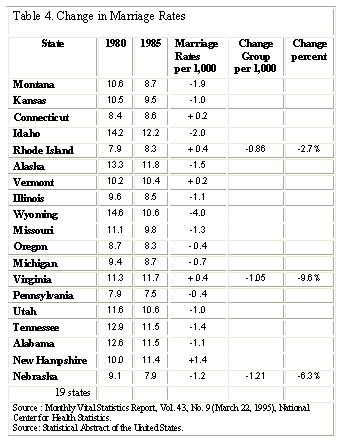 If the greater decline in divorce rates for High joint custody states results from declining marriage rates in previous years, then we would expect marriage rates for these states to show larger decreases in the early 1980s than the Low joint custody states. As can be seen from Table 4, the reverse is true.
If the greater decline in divorce rates for High joint custody states results from declining marriage rates in previous years, then we would expect marriage rates for these states to show larger decreases in the early 1980s than the Low joint custody states. As can be seen from Table 4, the reverse is true. Put simply, when divorce becomes a less attractive alternative to marriage, we should expect less divorce. As can be seen from the findings, this appears to be happening in states with higher levels of joint custody. If sole custody reduces incentives to continue marriage, then we should also expect states that favor sole custody to have more divorces involving children. As can be seen from Table 5, the low joint/high sole custody states also had more divorces involving children, although the difference is not statistically significant.
Put simply, when divorce becomes a less attractive alternative to marriage, we should expect less divorce. As can be seen from the findings, this appears to be happening in states with higher levels of joint custody. If sole custody reduces incentives to continue marriage, then we should also expect states that favor sole custody to have more divorces involving children. As can be seen from Table 5, the low joint/high sole custody states also had more divorces involving children, although the difference is not statistically significant.
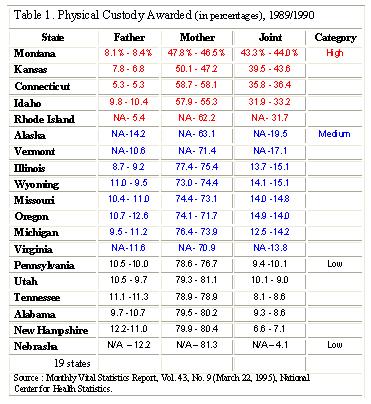

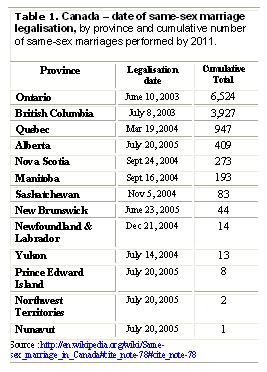


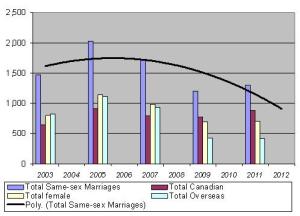


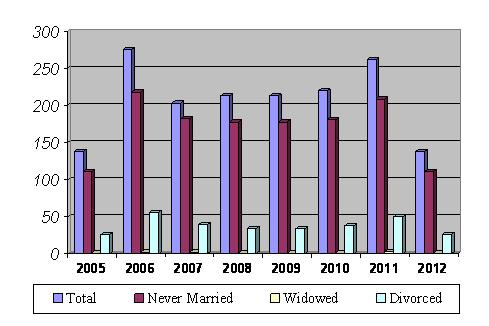
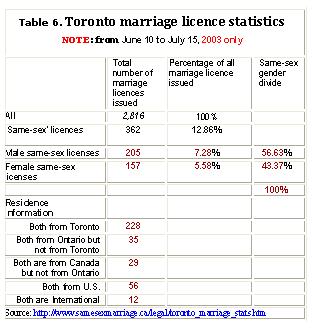
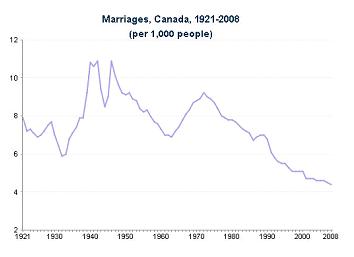
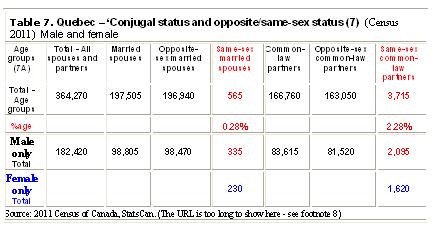



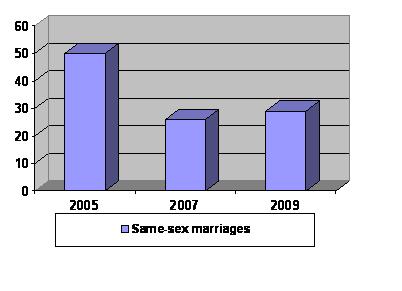
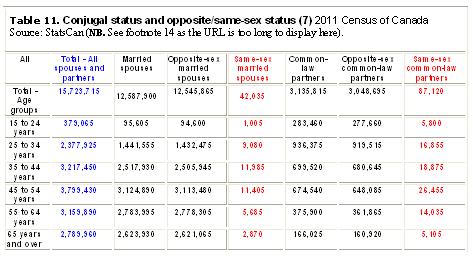
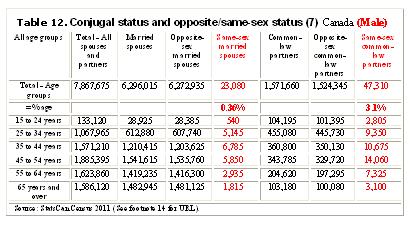





































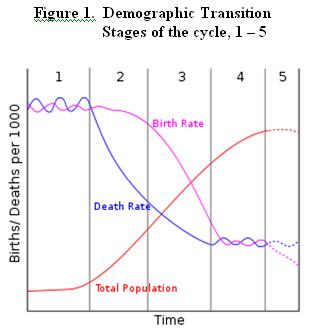

 In our own age we have seen these countries leap from Stage 2 to Stage 3 as their industrial base becomes established. China is perhaps the sole exception to the rule with it one-baby-policy yet booming economy.
In our own age we have seen these countries leap from Stage 2 to Stage 3 as their industrial base becomes established. China is perhaps the sole exception to the rule with it one-baby-policy yet booming economy.